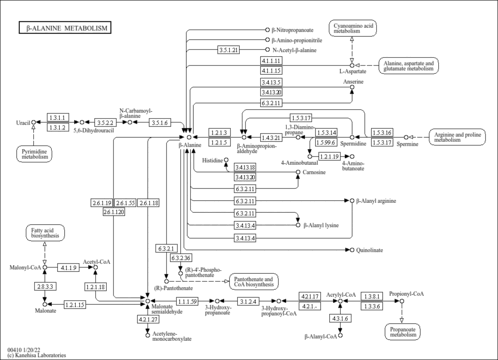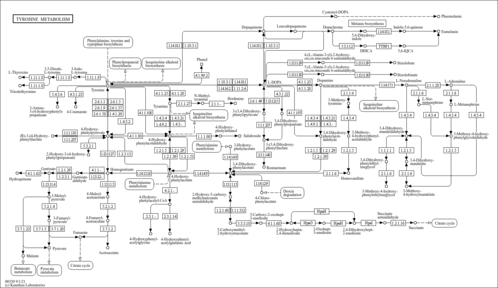| Record Information |
|---|
| Version | 1.0 |
|---|
| Created at | 2020-04-17 19:27:22 UTC |
|---|
| Updated at | 2020-11-18 16:39:39 UTC |
|---|
| CannabisDB ID | CDB005280 |
|---|
| Secondary Accession Numbers | Not Available |
|---|
| Cannabis Compound Identification |
|---|
| Common Name | Topaquinone |
|---|
| Description | Topaquinone, also known as TPQ, belongs to the class of organic compounds known as l-alpha-amino acids. These are alpha amino acids which have the L-configuration of the alpha-carbon atom. Topaquinone is a very strong basic compound (based on its pKa). Topaquinone exists in all living organisms, ranging from bacteria to humans. This residue catalyses its own transition, first to dopaquinone and then to topaquinone, in a Cu2+ dependent manner. It is used by copper amine oxidases which contain a tyrosine residue near the active site. In humans, topaquinone is involved in the metabolic disorder called tyrosinemia, transient, of the newborn. Its structure was first identified in 1990. Topaquinone (TPQ) is a redox cofactor derived from the amino acid tyrosine. Its name derives from 2,4,5-trihydroxyphenylalanine-quinone. Topaquinone is expected to be in Cannabis as all living plants are known to produce and metabolize it. |
|---|
| Structure | |
|---|
| Synonyms | | Value | Source |
|---|
| (S)-a-Amino-6-hydroxy-3,4-dioxo-1,5-cyclohexadiene-1-propanoate | HMDB | | (S)-a-Amino-6-hydroxy-3,4-dioxo-1,5-cyclohexadiene-1-propanoic acid | HMDB | | (S)-alpha-Amino-6-hydroxy-3,4-dioxo-1,5-cyclohexadiene-1-propanoate | HMDB | | (S)-alpha-Amino-6-hydroxy-3,4-dioxo-1,5-cyclohexadiene-1-propanoic acid | HMDB | | 2,4,5-Trihydroxyphenylalanine quinone | HMDB | | 6-Hydroxydopa quinone | HMDB | | 6-Hydroxydopaquinone | HMDB | | a-Amino-6-hydroxy-3,4-dioxo-(as)-1,5-cyclohexadiene-1-propanoate | HMDB | | a-Amino-6-hydroxy-3,4-dioxo-(as)-1,5-cyclohexadiene-1-propanoic acid | HMDB | | alpha-Amino-6-hydroxy-3,4-dioxo-(as)-1,5-cyclohexadiene-1-propanoate | HMDB | | alpha-Amino-6-hydroxy-3,4-dioxo-(as)-1,5-cyclohexadiene-1-propanoic acid | HMDB | | O-Topaquinone | HMDB | | Topa quinone | HMDB | | TPQ | HMDB | | 6-Hydroxydopa quinone, (6-OH-3,4-dioxo)-tautomer | HMDB | | 6-Hydroxyphenylalanine-3,4-dione | HMDB |
|
|---|
| Chemical Formula | C9H9NO5 |
|---|
| Average Molecular Weight | 211.17 |
|---|
| Monoisotopic Molecular Weight | 211.0481 |
|---|
| IUPAC Name | (2S)-2-amino-3-(6-hydroxy-3,4-dioxocyclohexa-1,5-dien-1-yl)propanoic acid |
|---|
| Traditional Name | (2S)-2-amino-3-(6-hydroxy-3,4-dioxocyclohexa-1,5-dien-1-yl)propanoic acid |
|---|
| CAS Registry Number | 64192-68-3 |
|---|
| SMILES | N[C@@H](CC1=CC(=O)C(=O)C=C1O)C(O)=O |
|---|
| InChI Identifier | InChI=1S/C9H9NO5/c10-5(9(14)15)1-4-2-7(12)8(13)3-6(4)11/h2-3,5,11H,1,10H2,(H,14,15)/t5-/m0/s1 |
|---|
| InChI Key | YWRFBISQAMHSIX-YFKPBYRVSA-N |
|---|
| Chemical Taxonomy |
|---|
| Description | Belongs to the class of organic compounds known as l-alpha-amino acids. These are alpha amino acids which have the L-configuration of the alpha-carbon atom. |
|---|
| Kingdom | Organic compounds |
|---|
| Super Class | Organic acids and derivatives |
|---|
| Class | Carboxylic acids and derivatives |
|---|
| Sub Class | Amino acids, peptides, and analogues |
|---|
| Direct Parent | L-alpha-amino acids |
|---|
| Alternative Parents | |
|---|
| Substituents | - L-alpha-amino acid
- O-benzoquinone
- Quinone
- Vinylogous acid
- Ketone
- Amino acid
- Cyclic ketone
- Carboxylic acid
- Enol
- Monocarboxylic acid or derivatives
- Amine
- Primary amine
- Organooxygen compound
- Organonitrogen compound
- Hydrocarbon derivative
- Organic oxide
- Primary aliphatic amine
- Organopnictogen compound
- Organic oxygen compound
- Organic nitrogen compound
- Carbonyl group
- Aliphatic homomonocyclic compound
|
|---|
| Molecular Framework | Aliphatic homomonocyclic compounds |
|---|
| External Descriptors | Not Available |
|---|
| Ontology |
|---|
|
| Disposition | Source: |
|---|
| Physical Properties |
|---|
| State | Solid |
|---|
| Experimental Properties | | Property | Value | Reference |
|---|
| Melting Point | Not Available | Not Available | | Boiling Point | Not Available | Not Available | | Water Solubility | Not Available | Not Available | | logP | Not Available | Not Available |
|
|---|
| Predicted Properties | [] |
|---|
| EI-MS/GC-MS | | Type | Description | Splash Key | View |
|---|
| Predicted GC-MS | Topaquinone, non-derivatized, Predicted GC-MS Spectrum - 70eV, Positive | splash10-00kf-4900000000-8000fefca905c692c6bb | Spectrum | | Predicted GC-MS | Topaquinone, 2 TMS, Predicted GC-MS Spectrum - 70eV, Positive | splash10-006x-9155000000-9f62f7d6a569a845f191 | Spectrum | | Predicted GC-MS | Topaquinone, non-derivatized, Predicted GC-MS Spectrum - 70eV, Positive | Not Available | Spectrum |
|
|---|
| MS/MS | | Type | Description | Splash Key | View |
|---|
| Predicted MS/MS | Predicted LC-MS/MS Spectrum - 10V, Negative | splash10-03di-0490000000-10cc522af99cf25fa607 | 2017-09-01 | View Spectrum | | Predicted MS/MS | Predicted LC-MS/MS Spectrum - 20V, Negative | splash10-03kl-2930000000-faaea6b1c3327a320404 | 2017-09-01 | View Spectrum | | Predicted MS/MS | Predicted LC-MS/MS Spectrum - 40V, Negative | splash10-00di-9500000000-8e842526e55c7606e107 | 2017-09-01 | View Spectrum | | Predicted MS/MS | Predicted LC-MS/MS Spectrum - 10V, Negative | splash10-03di-0790000000-264298b854c17cbd06c0 | 2021-09-24 | View Spectrum | | Predicted MS/MS | Predicted LC-MS/MS Spectrum - 20V, Negative | splash10-000i-0900000000-fa2a9a83c16bdc9743e5 | 2021-09-24 | View Spectrum | | Predicted MS/MS | Predicted LC-MS/MS Spectrum - 40V, Negative | splash10-000i-4900000000-edaf20a2d8ee4a49ed50 | 2021-09-24 | View Spectrum | | Predicted MS/MS | Predicted LC-MS/MS Spectrum - 10V, Positive | splash10-02tc-0920000000-d016b4dc13ff26872de2 | 2017-09-01 | View Spectrum | | Predicted MS/MS | Predicted LC-MS/MS Spectrum - 20V, Positive | splash10-014j-1900000000-e9e660167189a0f3df7b | 2017-09-01 | View Spectrum | | Predicted MS/MS | Predicted LC-MS/MS Spectrum - 40V, Positive | splash10-0gb9-9100000000-e330ba78cb2c450f79af | 2017-09-01 | View Spectrum | | Predicted MS/MS | Predicted LC-MS/MS Spectrum - 10V, Positive | splash10-03dr-0950000000-5c274a2daa8ac5fdb60f | 2021-09-24 | View Spectrum | | Predicted MS/MS | Predicted LC-MS/MS Spectrum - 20V, Positive | splash10-000j-1900000000-75224325d6d90326a3ce | 2021-09-24 | View Spectrum | | Predicted MS/MS | Predicted LC-MS/MS Spectrum - 40V, Positive | splash10-000i-5900000000-fb2113307dcb393ca87b | 2021-09-24 | View Spectrum |
|
|---|

